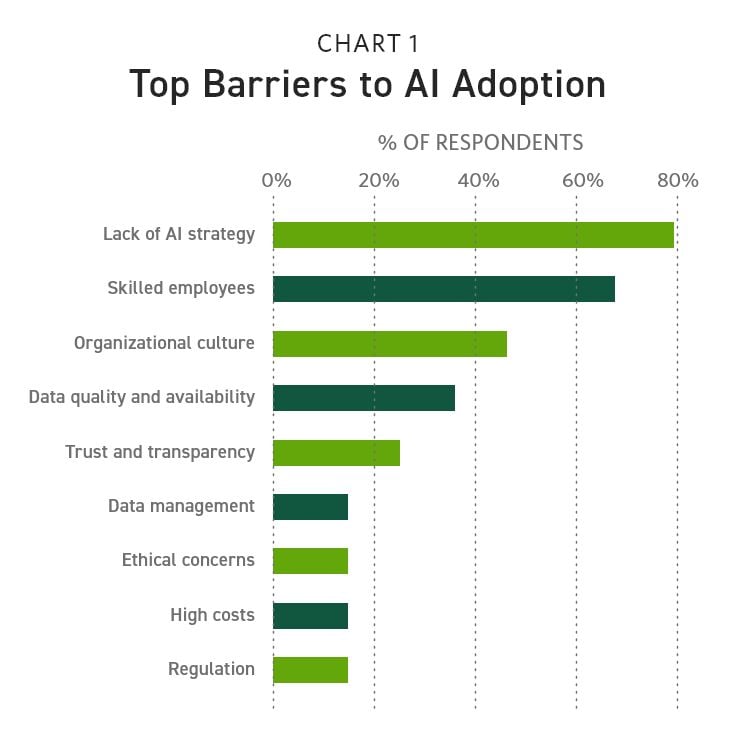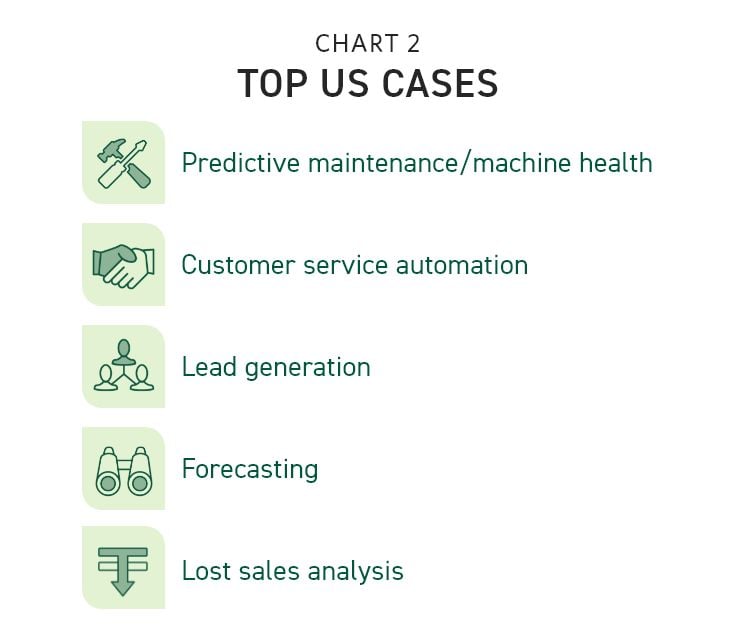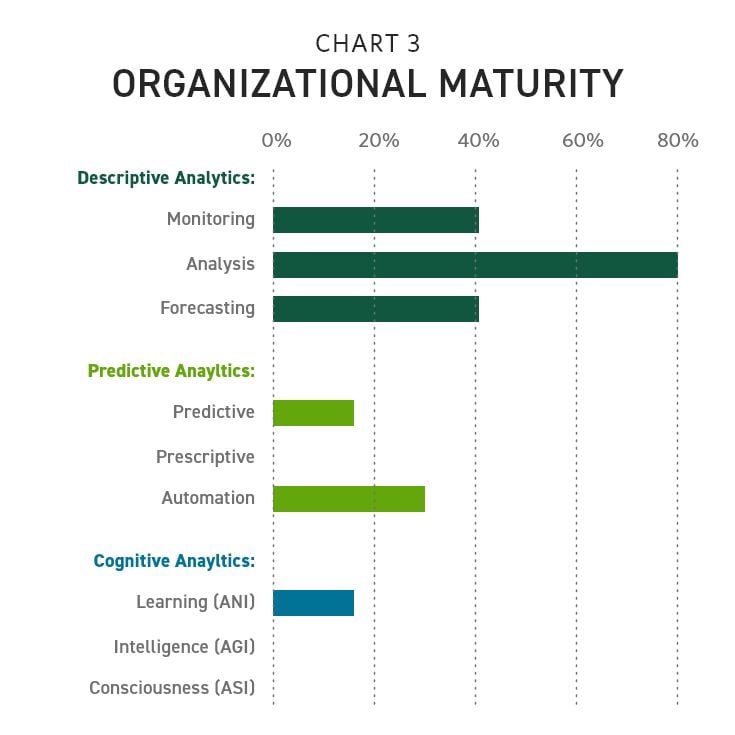The impact of artificial intelligence on how we live, work and do business has been undeniable for over a decade. Its practical applications range from suggesting the next sentence when crafting emails to producing lifelike animations, from enabling smart and interconnected manufacturing robots to efficiently distribute workloads on assembly lines to predicting customers’ preferences or even helping land a plane.
Artificial intelligence is a broad term for technology that builds upon pattern recognition to make predictions, which are the foundation of robotic process automation, machine learning and natural language processing.
The sudden explosive growth of generative AI over the last 12 months made it inescapable and ignited expectations about the power and potential of AI for business growth. CEOs view AI as the top technology that will impact businesses in the near future. Ignoring AI is not an option – but how to parse through the hype and harness AI for corporate growth?
To answer this very question, the Chief Executive Group and Cherry Bekaert convened a roundtable discussion of a dozen CEOs in Nashville in November 2023. The roundtable participants represented a range of industries, from consulting and professional services to software, to insurance, to the manufacturing of auto parts and electronic components, and more. They talked through their expectations, experiences and challenges with AI.
The conversation revealed that when facing, evaluating and implementing AI, the CEOs’ top barrier is the lack of AI strategy. (See Chart 1.)
The following report describes the methodology for creating an effective AI strategy and provides examples of successful practical applications of AI. The ultimate success of every methodology depends on asking the right questions. In the case of AI, these questions are:
- How to create a successful AI strategy?
- Why use AI technologies?
- How to structure AI programs for success?
- How to engage our people with AI programs?
- Should we consider a partner for AI strategy and implementation?

How to Create a Successful AI Strategy?
AI strategy is part of a company’s overall growth strategy — AI implementations need to be directly linked to creating business value, not to enhancing technology capabilities. Depending on the desired business goals — revenue increase, product innovation, cost efficiencies or something else — the next decisions are whether and how AI technologies can be useful, and then about the areas of the company where solutions can be successfully deployed first.
Considering the current status of AI as the hot technology, it may be tempting to be led by specific AI capabilities, be they predictive or cognitive analytics. “The AI strategy should be guided by business value. Otherwise, it’s the business equivalent of a tail wagging the dog,” says Richard Schwartz, a partner at T&Co by Cherry Bekaert.
One of the questions the CEOs at our roundtable grappled with was: How do we balance the risk of falling behind in AI against the threat of chasing an expensive bright shiny object? Schwartz recommends the following:
Rely on Experience with Navigating Past Technology Revolutions
AI is not the first technology to capture the imagination, and it won’t be the last. Businesses have been executing digital transformations for a while, spearheaded by the dawn of ERP systems in the 1990s, then internet and mobile applications in the 2000s. A couple of years ago, the metaverse offered a whole new virtual reality for conducting business, becoming the then new and shiny object. Having fizzled somewhat in terms of hype over the past year, the metaverse has now been superseded by generative AI in terms of its transformative potential and urgency.
Determine The Appropriate Scope
What is the right scope of the AI strategy? Typically, companies display different levels of maturity of AI applications across functions, with the primary, bread-and-butter function being the most advanced. For example, a manufacturing company may excel at using AI for predictive maintenance, while a high-volume financial transaction firm may be AI-advanced in deploying chat bots to service customers. On the flip side, sales, marketing or human resources may be lagging in terms of AI maturity in such companies. The same differentiation of maturity and adoption across functions exists with other technologies, such as ERP, CRM and mobile. After maturing the primary function, the support functions should come along as the organization grows, scales up and standardizes its processes.
“The question of the scope and speed of AI implementation boils down to the maturity of a business as a whole,” says Kristel Kurtz, a partner at T&Co by Cherry Bekaert. “Technology solutions from different areas may look dissimilar at first glance but have the same underpinnings. Are you able to take some of your learnings from one area of your company and apply them to other areas?”
Decide If You Need to Be a Leader or a Fast Follower
Do we need to lead in AI initiatives? The implementation of AI is often a response to what competitors in the industry are doing. Being a fast follower is an effective and relatively safe way to learn from the experience of others and improve on the existing solutions. “The decision about whether to take the paved road or become a disruptor in terms of AI, just like any other strategy decision, needs to start with business value – which approach will most efficiently lead to what the company is solving for,” advises Luis Gallardo, a partner at Cherry Bekaert.


Why Use AI Technologies?
AI technologies can be used across multiple functions and for different use cases – from predictive maintenance and process optimization to personalization of customer communications and autonomous driving. How, and where, AI solutions are utilized will vary depending on the industry and the company’s maturity. The CEOs present at the roundtable were most likely to use AI for predictive maintenance and customer service automation. (See Chart 2.)
Predictive maintenance — in effect, AI-driven software programs monitoring equipment and flagging when a machine is about to break down or a part is wearing out – prevents or reduces production downtimes, prolongs equipment life, maximizes efficiency and, most important, improves worker safety. Cherry Bekaert’s Schwartz also pointed to the potential of AI in engineering and design, by applying simulation and digital twins to create machines and structures that will be sound from the risk management standpoint.
The use of artificial intelligence in customer service automation has by now become table stakes, especially in the b2c arena. For example, AI chatbots can carry on conversations with customers, answering their questions, asking follow-up questions and resolving issues. They accomplish that by combining natural language processing (NLP), machine learning (ML) and artificial intelligence (AI), which allows them to interpret written or spoken human messages, engage in human-like conversations and provide solutions.
AI-driven tools involve data analytics. Much of the success of the AI program will depend on data management. Issues to consider:
Levels of the Complexity of Data Analytics
Different types of analytics have different levels of complexity. Not surprisingly, most of the roundtable attendees report using the most basic type — descriptive analytics. This type of analytics includes historical data, such as year-over-year revenue growth, the number of users or user engagement, or revenue per subscriber. AI takes descriptive data into the predictive realm by recognizing patterns. For example, businesses can use machine learning to identify fraud patterns, predict customer churn or recommend products based on customer preferences. In predictive maintenance, for example, AI analyses data sets from machines to predict the future health of machines and suggest actions. In cognitive analytics, AI systems can learn from the data and apply human-like intelligence.
Correlation Between Analytics Complexity and Business Value
Typically, the higher the level of organizational maturity in terms of the levels of artificial intelligence and automation — with descriptive analytics being the most basic and cognitive analytics being the top level of sophistication — the higher the derived business value. Most of the roundtable participants reported the basic levels of organizational maturity, and very few employed cognitive analytics, which is the characteristic of the highest level of maturity. Cherry Bekaert’s Kurtz stresses that the right approach to AI is to consider business goals first, and to not get too mired in academic discussions about the sophistication of different technologies.
Data Quality Management
Part of the hesitation when embarking on data-driven AI programs are the misgivings that CEOs have about the quality of data. During the roundtable, CEOs discussed data silos, inconsistent formats and overall data integrity. Data-related issues, such as quality and availability of data and data management ranked high on the list of top barriers to AI implementation. (See Chart 1.) While stressing the need for long-term strategic planning in data management, Cherry Bekaert’s Gallardo also advocated for potentially using AI to tackle unstructured data. He noted that AI proficiency with unstructured data opens new avenues for data utilization that traditional data management systems may not fully exploit.

How to Structure AI Programs for Success?
CEOs have the capacity to harness AI for the growth of their organizations, because they have led multiple other growth programs. “Implementing AI strategies does not call for a total change of paradigm – it follows fundamental business principles that apply to most growth or efficiency initiatives,” says Cherry Bekaert’s Schwartz.
Observe the following tenets when deciding on AI programs:
Start with Business Value
Like all investments and projects, AI pilots and implementations start with a value case, solution evaluation, timelines and resource allocation that can be tracked through key milestones, which allow CEOs to decide to move forward and scale or move on to the next opportunity.
“CEOs need to start with the business value they want to achieve and reverse engineer through all the possible roads to take to get to that value,” says Cherry Bekaert’s Gallardo. All viable options should be considered, including not changing the current method. And while AI has become the top technology, it may not be the only option to execute the program. Decide whether you need to be on the leading edge with the program in question, and if the answer is yes, select the AI option if it will take you there.
Weigh the Importance of Urgency and Stakeholders’ Expectations
While the basic playbook for AI-driven programs is the same as for other growth or efficiency initiatives, AI stands out as being one of the technologies that consumers can experience themselves. This puts additional pressure and urgency on businesses, as consumers and b2b partners expect companies to provide them with the type of experience that keeps up with what they encounter in their everyday lives.
Make Decisions in the Context of Your Business
While the overall paradigms of decision-making are the same, each situation is specific not only to the company’s business but also to its organizational maturity, ability to handle change, available resources (both budgets and talent), existing competitive pressures and company size. “So often AI journeys are talked about in the context of a big enterprise,” says Cherry Bekaert’s Kurtz. “We are looking also at what AI means for a mid-market or a small business: What are the applications? Is it approachable? Is the technology ready for you?”
The following real-life case studies illustrate different use cases of AI tools – from a packaged goods company innovating the next round of cleaning products to an engineering firm optimizing its RFPs review process, to a manufacturing firm enhancing its working capital management – and the questions that CEOs need to ask themselves when making decisions on how best to employ AI.
Example 1: Adapting to Consumers’ Cleaning Habits After the Pandemic
|
Solving for: |
After the pandemic, during which consumers put extra focus on cleaning products, a packaged goods company was facing decreasing sales of some of its cleaning products and changing consumer preferences. The post-hand-sanitizer era called for a new approach to operational efficiency, market research and product innovation. |
|
Business goal: |
Better productivity on designing the next batch of products. |
|
Current approach: |
Traditional market research: ethnographic researchers in the field observing consumers; consumer focus groups; surveys. The typical timeline to develop a product concept was 9-12 months. |
|
Questions to consider: |
Have we gotten breakout results from the current method? What are the costs of the current method? What’s the role of technology in the current method? What are the other ways to do it? |
|
Test available solutions in terms of cost-effectiveness, efficiency and benefits. |
Continue with current method. Outsource product research to another firm. Consider using AI-driven technologies. |
|
Best outcome: |
AI-driven sensing and scanning tools can automate the product innovation process and conduct sentiment analysis on a much bigger data set much faster, providing deeper and more nuanced insights. Generative functions AI can synthesize qualitative and unstructured data and translate insights into the next 3 products to develop. It can do it faster and with broader consumer reach than traditional methods reducing the development time by 3-6 months. |
Example 2: Automating RFP Pipeline to Win More Business
|
Solving for: |
Engineering firm with aggressive growth ambitions wanted to scale its business and become one of the top firms in the U.S. It needed to be faster to market with responses to relevant RFPs. |
|
Business goal: |
Better evaluate/narrow down the project pipeline to quickly pinpoint relevant RFPs and increase the yield on the pipeline. Win projects by aligning them faster with the right people/capabilities within the organization. |
|
Current approach: |
Manual analysis: time consuming, stressful, imprecise, inconsistent. |
|
Questions to consider: |
What are the win rates generated via the current method? How cost-effective is the current method? How do we use technology in the current method? |
|
Test available solutions in terms of cost-effectiveness, efficiency and benefits. |
Continue with current approach. Test AI-driven proposal tools. |
|
Best outcome: |
AI tools help increase RFP win rates and prepare high-quality responses efficiently and accurately. The AI-driven programs also create a single source of truth and update templates or create new ones. |
Example 3: Optimizing Working Capital Management
|
Solving for: |
Optimize working capital management to enhance investment and business growth. |
|
Business goal: |
Activate working capital: increase cash on hand, look for and eliminate leakage. |
|
Current approach: |
Teams of people looking through accounts payables and accounts receivables trying to discern compliance and payment terms, looking for anomalies and discrepancies. |
|
Questions to consider: |
Are we maximizing working capital with the current approach? Is our current approach consistent and clear to our employees, vendors, and customers? How cost-effective is the current approach? How are we using technology in the current approach? Are there better ways of handling expense approval, invoice payment, and customer credit and collections compliance? |
|
Test available solutions in terms of cost-effectiveness, efficiency and benefits. |
Continue with current approach. |
|
Best outcome: |
Utilize AI-driven credit and collection crawl tools to secure consistent and optimal terms (not necessarily the shortest payment terms) and increase working capital; introduce clarity, leading to customer and vendor satisfaction. |
How to Engage our People With AI Programs?
As the world’s top academics have noted: AI will not replace people, but the people who use AI will replace those who do not. While AI in the workplace may seem like a new and advanced technology, jobs will continue to evolve, with AI being a critical part of a modern learning organization. Just as laptops and cell phones have gone from being exclusive and expensive accessories to daily business tools, AI will be integrated into daily life. “ERP and CRM are now table stakes, and AI is a new tool that will help companies continue to refine and increase productivity or the value of their services,” says Cherry Bekaert’s Kurtz.
This is not yet the case today. In fact, CEOs at the roundtable recognized that people issues – skilled employees and organizational culture – are among the top three barriers to adopting AI, following lack of AI strategy. (See Chart 1.)
AI applications can enhance the quality and productivity of skilled employees as well as support training for new positions. For example, when the packaged goods company described in the previous section (Example 1) decided to bring in AI processes to product innovation, it meant relying less on ethnographic researchers and in-person focus groups and more on AI-driven technology tools. In another instance, an insurance company CEO present at the business roundtable is considering enhancing the work of insurance brokers with AI tools. In all such cases, the roles and work processes of many employees will change.
To ensure employee engagement, change management needs to involve communicating the strategy and execution of the AI-driven transformation, structuring AI programs to make sure they deliver quick wins, and turning AI champions into company-wide AI ambassadors.
Communicate Early, Often and Clearly
Explain how AI technologies are going to supplement the teams, what new skills will be necessary, and when and how employees can acquire such skills. Get top executive buy-in and participation in the change management communications.
Deliver Quick Wins
Cherry Bekaert’s Gallardo suggests at first targeting small manageable areas where quick improvements can be made that represent opportunities for immediate gains in efficiency, accuracy and speed. There is nothing better for acquiring the momentum for organizational change than getting quick wins and some early success.
Turn AI Champions into Company-Wide Ambassadors
They can then motivate teams by sharing the successes with AI of the more mature parts of the organization. The more specific the examples, the more likely they will be followed across other functions, advises Schwartz. Information about AI implementations should explain specific results and cost-effectiveness, as well as how the teams, work processes and business models were restructured to take advantage of AI. In this way, the rest of the company will get a real-life, practical guide to AI implementation.
Should we Consider a Partner for AI Strategy and Implementation?
Every new project starts with the decision about whether it can be carried out in-house or whether it’s more advantageous to team up with a partner. The basis for the decision lies in the scale of the project, its urgency, available resources and a cost-benefit analysis.
“Bringing in outside help is often a catalyst to get something started, and the investment demonstrates the importance of the project,” says Kurtz
Companies that need to act fast, face many competing priorities and lack internal expertise are better off with a partnership. An outside partner will provide an injection of expertise and capacity, but the relationship will work only if the partner is evaluated in the context of the organization. Major areas to consider when deciding on a partner are:
A Trusted Advisor Versus a Technology Vendor
The scope of assistance a partner can provide varies. Some partners work with clients on the practical applications as well as on the overall strategy and its implementation. They help solve the implications of the AI program for the operating model and work processes within a specific function or the whole organization. “The full journey component is the foundation of our work with clients,” says Cherry Bekaert’s Gallardo. There are also firms that specialize in specific uses or technologies, but do not help the clients with their whole AI project lifecycle. If you need help with project and change management, then go for the partners who can connect all the dots of the AI program.
Tailored Approach or Off-the-shelf Solutions
Select a partner that has experience with companies like yours in terms of size, industry, AI maturity level, available in-house talent and your commitment to AI. The needs of an enterprise-size corporation, a middle-market firm and a small company are very different and require a different type of approach. For example, middle-market clients are not in the business of experimenting with AI for the sake of experimentation. In contrast, bigger organizations make big disruptive AI bets, not all of which will pan out.
Practical Experience with Specific Projects Versus General Knowledge
Not all partners have experience with specific issues your company is solving for or specific technologies that apply to your issues. Pay attention to the partner’s use cases, technology ecosystem and their partnerships with major technology players. In some cases, there may be dozens of AI sensing technologies to select from. The right partners will understand which technology will fit your needs best. “Decide if you are willing to work with a partner who is learning alongside you, or if you would rather have someone in the know,” advises Schwartz.
How Cherry Bekaert Can Help
AI is forcing middle-market companies to upgrade their digital transformation efforts. Cherry Bekaert has extensive experience in developing strategies for AI deployments in practical business use cases.
Our Digital Advisory team is comprised of strategists who have broad industry experience and keen business acumen. Utilizing an agile and flexible approach, we help examine your goals with a focus on people, process, technology and culture. Our Strategic Growth & Innovation team equips you with the right AI tools to transform data into actionable insights and strategies that drive real-world results. We are here to help organizations manage risks, enable growth and support sustainable operations.
A collaboration with:




